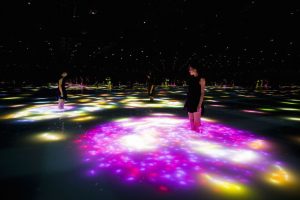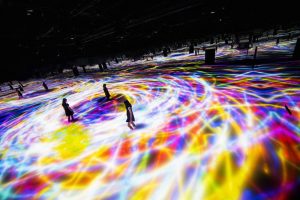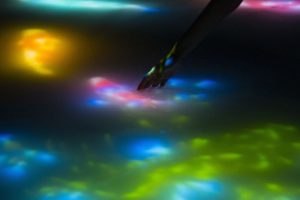/* Jaclyn Saik
Project-02
Section E
*/
//face and hair variables
var eyeSize = 20;
var pupilSize = 10
var faceWidth = 150;
var faceHeight = 170;
var bunWidth = 100
var bunHeight = 100
var armLW = 160
var armRW = 480
var toungeL = 40
var toothL = 10
var eyebrowH = 155
var bluehair = 50
var redskin = 238
function setup() {
createCanvas(640, 480);
}
function draw() {
background(140, 120, 170);
noStroke();
//colors
s = color(redskin, 216, 193) //skin
r = color(206, 20, 110)
b = color(223, 140, bluehair)
//body
fill(s)
//arms
triangle(245, (height / 2) + 20, 240, 380, armLW, 600);
triangle(235 + (width / 4), (height / 2) + 20, 235 + (width / 4), 380, armRW, 600);
fill(r)
rect(240, height / 2, width / 4, height*(2/3), 20)
//hair
fill(b)
ellipse(width / 2, height / 3 + 5, faceWidth + 20, faceHeight + 40)
ellipse(width / 2 - faceWidth * .6, height / 3 + 50, bunWidth, bunHeight)
ellipse(width / 2 + faceWidth * .6, height / 3 + 50, bunWidth, bunHeight)
//face
fill(s)
ellipse(width / 2, height / 3 + 25, faceWidth, faceHeight);
//eyes
var eyeLX = width / 2 - faceWidth * 0.25;
var eyeRX = width / 2 + faceWidth * 0.25;
var pupilLX = width / 2 - faceWidth * 0.25;
var pupilRX = width / 2 + faceWidth * 0.25;
fill(255);
ellipse(eyeLX, height / 3 + 15, eyeSize, eyeSize);
ellipse(eyeRX, height / 3 + 15, eyeSize, eyeSize);
fill(0)
//pupils
ellipse(eyeLX, height / 3 + 15, pupilSize, pupilSize);
ellipse(eyeRX, height / 3 + 15, pupilSize, pupilSize);
//tounge
fill(237, 106, 169)
ellipse(width / 2, height / 3 + 65, 30, toungeL)
//teeth
fill(255)
rect(width / 2 - 5, height / 3 + 60, 15, toothL)
//mouth
fill(s)
rect(width / 2 - 25, height / 3 + 50, 50, 10)
//nose
var noseWL = 300
var noseWR = 340
fill(247, 208, 95)
triangle(width / 2, height / 3 + 10, noseWL, height / 3 + 50, noseWR, height / 3 + 50);
//eyebrows
noFill();
strokeWeight(3)
stroke(218, 130, 55)
arc(eyeLX, eyebrowH, 40, 25, PI*1.2, 0, OPEN)
arc(eyeRX, eyebrowH, 40, 25, PI, TWO_PI*.9, OPEN)
}
function mousePressed() {
faceWidth = random(125, 150);
eyeSize = random(20, 50);
pupilSize = random(10, 15)
bunHeight = random(60, 120);
bunWidth = random(60, 120);
armLW = random(120, 200);
armRW = random(440, 520);
toungeL = random(30, 90);
toothL = random(10, 17)
eyebrowH = random(160, 145)
bluehair = random(20, 200)
redskin = random(100, 255)
}This was an interesting task, and definitely very fun to research. I especially liked looking into how artists like Moka create algoritm-generated faces, and how the randomization tools of computers really highlight the odd ways our brains look and recognize facial expressions. Instead of working in a sketchbook, my main method of “sketching” for this project was first creating the static elements of my figure, so originally the arms and torso, and then playing with different features layered on top of each other to see what type of expressions come out. I found it especially interesting how much power the pupils and eyebrows have over a person’s expression.
![[OLD FALL 2018] 15-104 • Introduction to Computing for Creative Practice](https://courses.ideate.cmu.edu/15-104/f2018/wp-content/uploads/2020/08/stop-banner.png)


